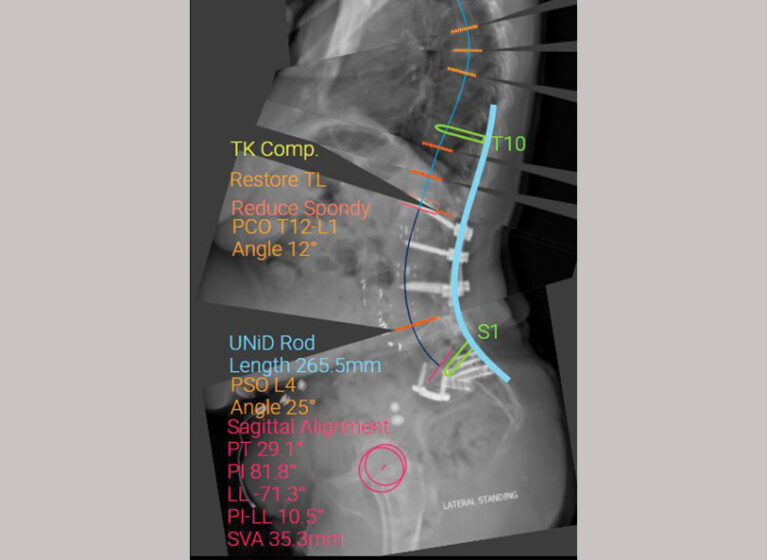
At UVA Health, we perform more than 1,500 spine procedures a year. We’re always striving to deliver the best outcomes to our patients. That means participating in research and exploring new technologies and techniques that advance the possibilities for all patients.
It also means we can help patients when other treatments have failed. In this case, a 74-year-old woman was seeking relief from years of back pain. She came to UVA Health after several previous surgeries.
“The patient could not stand up straight. She always seemed bent forward. When she came to see me, she was in a wheelchair,” says Xudong Li, MD, an orthopedic surgeon at UVA Health who specializes in spine surgery. “When she saw me, her spine was fused from L1 to the sacrum.”
Using innovative tools before and during the procedure, combined with years of experience in spinal surgery, Li and the UVA Health orthopedic surgery team performed a revision surgery that corrected her back issues and ended years of pain.
Five Surgeries Lead to Flat Back Syndrome
The patient presented with a proximal junction failure and a flat back without a natural lumbar curve. She had undergone 5 previous surgeries on her back, the most recent being 2 years prior. The previous surgeries had been performed elsewhere.
These surgeries had left her with a fused lower spine and junction issues. “Her L1 screw was going into her T12 – L1 disc,” explains Li. “I talked with her and told her it was going to be a big surgery. But I also told her we have new technology, and the robots, to place the screws and personalized rods.”
Special Tools Make a Map to Success
Before the surgery, Li’s team used special software to measure her spine. “Because of her previous fusion surgeries, we couldn’t see her anatomy very well,” explains Li. “It’s not safe to put in the pedicle screws without knowing the anatomy.”
The software allowed them to map out the ideal screw placement. Then, that data was also used to create 2 custom rods bent to the exact needs of the patient. Li and his team have since adopted these techniques as part of their usual work. “For all my deformity surgeries now, I use patient-specific rods,” Li says.
“We also took advantage of a database of spinal deformity,” recalls Li. The database helped Li and his team determine the exact amount of rod curvature that was ideal for this patient.
Restoring the Curve in a Flat Back
The surgery involved a 3-column osteotomy to restore the correct spinal curve. During the osteotomy, Li made a wedge-shaped cut in the vertebrae, then closed the gap. This ultimately created a 25-degree curve in the patient’s spine. The patient’s spine measurement data also helped guide the robot that placed her pedicle screws.
Additionally, a flexible surgical table was used during surgery. The table allowed Li’s team to avoid possible complications from osteopenia. “The table can flex and extend. That puts force on her whole spine, rather than just the couple of pedicle screws,” recounts Li.
A New Lease on Life
Ultimately, the surgery was a success. The patient recovered and now lives without chronic back pain.
Just recently, Li received a text from the patient, thanking him for his work. The text read: “Two years ago today, God worked through you to do my back surgery. I will always be thankful for God putting you in my life and my family’s life… You gave me a new lease on life. You will always hold a special place in my heart. All my family loves you.”